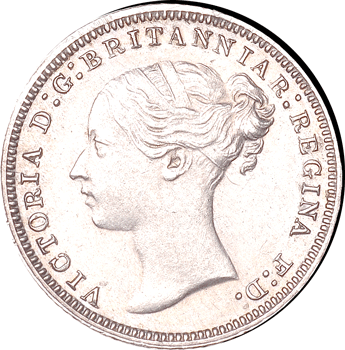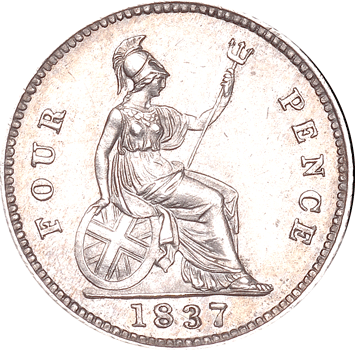|
Michael Coins Ltd |
![]() Other Lists
Other Lists
COIN CLUB


1837 Groat (proof)
1837 groats are Extremely Rare and has been struck with the obverse Type 3
silver threepence die* as used for the Victorian threepence* from 1866 to 1879.
Groats had stopped being struck in 1862.
*The Groat and Threepence used the same obverse die.
The 1837 Groat was struck between 1866 to 1879. As will be suggested,
probably, in the mid to late 1870's and is therefore a later re-strike coin.
A possible explanation for this coin will be give further down this page.
Groat 1837 - Obv. Is the 3rd bust variety. There are now many more border teeth and
Victoria's bust is now slightly larger and in lower relief. Her mouth is fuller
and her nose slightly more pronounced. The back of the truncation is smoother
and less sharp. Victoria's hair now covers the top of her ear. The first I of
VICTORIA now points to a border tooth.
2 different examples of this coin are know.
Listed with a plain edge ↑↑ (This is the rarer type) Guesstimate of 1 to 2 known.
Listed with a milled edge ↑↓ Guesstimate 3 to 4 possibly known.
Listed in the Spink Coins of England 2017, page 470, as:
1837 Plain edge proof: £12,500.00 [ESC 3317 & Davis 1200 E]
1837 Milled edge proof: £11,500.00 [ESC 3318 & Davis 1200 P]
Known examples:
Seaby's (Coin dealer, London) Sold in their Coin & Medal Bulletin possibly December 1983
I have not been able to establish what price it sold for, as yet. VF+ Milled edge. Die axis ↑↓
Images of the coin is on page 309 of the above mentioned Bulletin.
Dix Noonan Webb (DNW), 14 June 2017, Lot 315, pAS
Sold for £8,500.00 plus buyer premium of £2,040. Total price.......£10.540.
Milled edge. Die axis ↑↓
Dix Noonan Webb (DNW), 14 June 2017, Lot 316*, Graded by DNW as Obv. Fine+ Rev. VF
Sold for £3,200.00 plus buyer premium of £768.00. Total price.......£3,968.
* Most probably the Seaby coin of 1983 as both coins have the identical same slight dark
rim mark on the obverse at 11 o'clock. Milled edge. Die axis ↑↓
I have yet to find an example of the plain edge having been sold.
An explanation for why this unusual coin could have occurred.
The use of a later period Victorian obverse die on this coin (circa 1866 - 1879)
proves without doubt that the coin could not have been produced in 1837.
I am indebted to Graham Dyer (Senior curator at the Royal Mint) & Peter Gaspar
for their article that was published in the Seaby Coin & Medal Bulletin, No. 784,
December 1983, pages 307 to 310 and for the research that they did into this coin.
A précis of that article concludes that the Royal Mint records, unfortunately,
do not indicate the specific circumstances in which this and other Victorian
1837 re-strike Groat was made.
What is known is that this particular reverse die is lodged in the Royal Mint
collection (image of that die on page 309 of the Bulletin) and had been used to
strike two proof William IV Groats of 1837 that are in the Royal Mint collection.
Both of these coins have been confirmed as having been struck in the 1870's.
In the Royal Mint collection: 1837 William IV, milled edge proof Groat, Die axis ↑↓
ESC 2521 (old 1923). Davis 384 P. Thought now to be with obverse type 4.
In the Royal Mint collection: 1837 William IV, plain edge proof Groat, Die axis ↑↑
ESC 2522. Davis (unlisted). Thought also to be with obverse 4.
It is known that the re-striking of coins was a regular occurrence, sometimes
to provide coins for exhibition purposes, such as the Sydney & Melbourne
Exhibitions, in Australia in 1879 and 1880. Sometimes for the Royal Mint's
own collection in 1873, the Ashmolean Museum collection in 1891, other public
collections and even sometimes to gratify private collectors. It is quite possible,
that the Royal Mint officials, not being numismatists could have had a request
for a specimen of the first Victorian Groat and had mistakenly assumed that
the first dated coins were of 1837 as Victoria ascended the throne on
20 June 1837 and as they had a convenient 1837 reverse die in their collection
it was used. It is possible that there were no early Victorian dated dies left in
stock. Also as there were no early Victorian obverse die available a new die
of that period was used (a Victorian obverse type 3 obverse die). Thereby
helping us ascertain in what period this 1837 Victorian Groat was struck.
The 1837 Victorian Groat is a re-strike but in this case collectors do not care
as it is an anomaly and unusual and certainly a prize for any collection.
My thanks to BP & SF for their help with this article.
| Back to Groats |